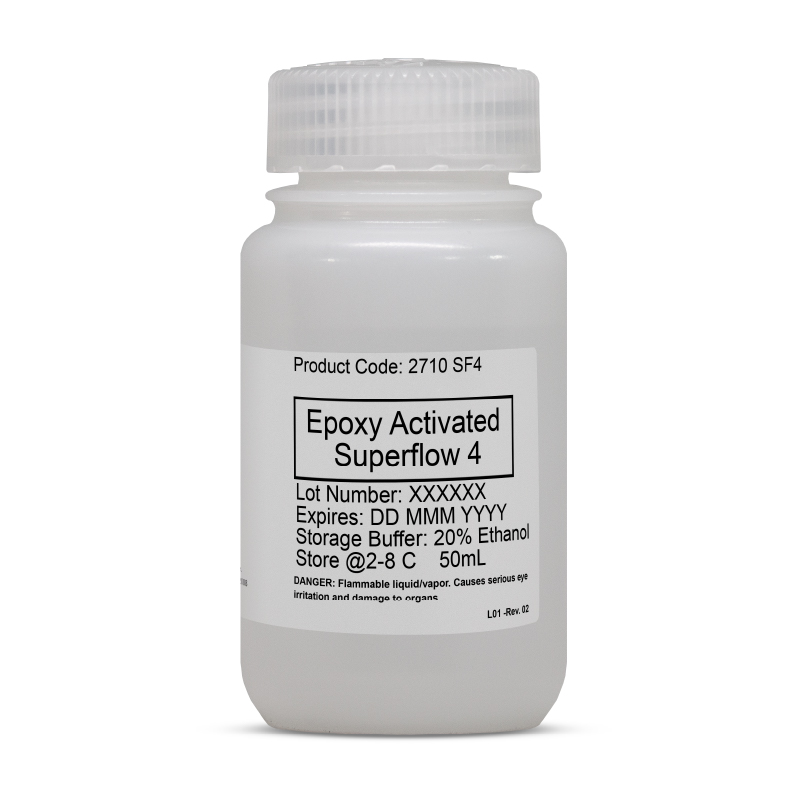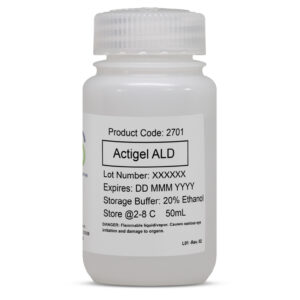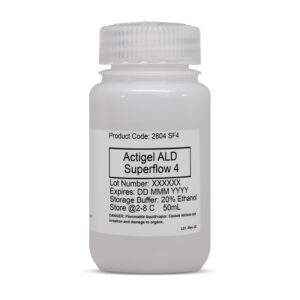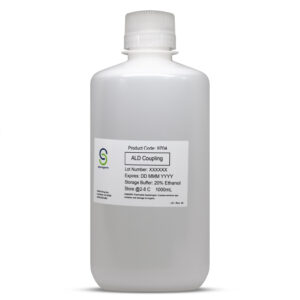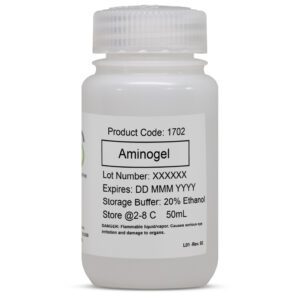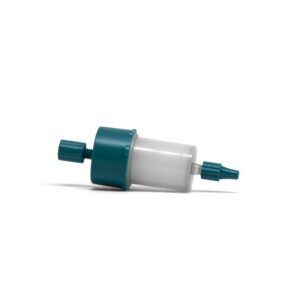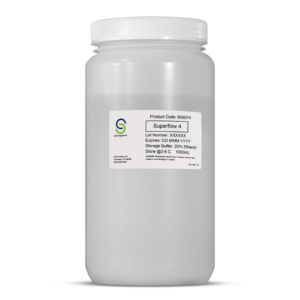Table 1. Resin Characteristics
| Active Group Density
| >50 µmole/ml
|
| Bead Material
| Agarose |
| Bead Percentage
| 4% |
| Bead Size | 60-160 µm |
| Flow Rate1 | >30 mL/min (>1020 cm/hr) @ 25oC |
| pH Stability2 | 2-7 |
| Storage Temperature | 2-8o C |
| Storage Buffer
| 20% Ethanol |
| Form | Slurry |
| Chemical Stability2 | Stable in all commonly used aqueous solutions and buffers. |
| Physical Stability2 | Negligible volume variation due to changes in pH or ionic strength. |
1Linear flow rate = volumetric flow rate (cm3/h)/column cross-sectional area (cm2)
2Data refer to the coupled product, provided that the ligand can withstand the pH or chemical environment. Please note the following: pH stability, long term refers to the pH interval where the medium is stable over a long period of time without adverse effects on its subsequent chromatographic performance. pH stability, short term refers to the pH interval for regeneration and cleaning procedures.
Instructions for Use
Before you start
Measure the required amount of suction-dried resin. Wash the resin in a Buchner funnel or empty column with 5 bed volumes of DI water. Then wash the resin with 3 bed volumes of the appropriate coupling buffer (depends on which group you plan to couple). Remove the excess buffer by gentle suction. Transfer the resin into a beaker or flask. Reference the appropriate heading succeeding this general protocol for additional information relating to your coupling of amino-, thiol-, or hydroxyl-groups.
Coupling through the primary amine:
Epoxy chemistry couples to primary amines at pH 8-10. Therefore, when buffers containing amines are used, you will get low coupling efficiency of your ligand. Hepes or other Good’s buffers can be used.
Coupling takes place at pH 8-10 and at a temperature of 2-40 °C. The pH and temperature used should be compatible with the ligand. Most primary amines can be efficiently coupled at around pH 8.5. However, sometimes there are exceptions where a need for pH optimization arises. In such a scenario, optimal coupling pH can be determined in pilot experiments by increasing the pH by one-unit increments in the range of pH 8-10. Coupling ideally should be carried out at a pH that lies in the range of activity for the protein ligand. Coupling at a pH other than the pI yields higher retained activity of the immobilized protein.
Dissolve the desired amount of ligand in the same volume of 0.1M Sodium phosphate, pH 8.5, as the resin. Add this solution to the resin and agitate the suspension for 18 hours (see the note below on coupling time). Filter in a Buchner funnel or empty column and measure the ligand concentration in the filtrate. Calculate the coupling yield. If it is less than 90%, combine the filtrate with the resin and continue the coupling until the filtrate yields a ligand concentration that indicates adequate coupling efficiency. Filter again and wash the resin with 10 volumes of running buffer.
Coupling through the thiol:
Epoxy Activated Superflow 4 reacts with thiols in the pH range of 7.5-8. It will be best to couple closer to 7.5 as 8 approaches the pH range at which primary amines will begin to couple. Prepare your ligand in a buffer that does not contain thiol groups, as their presence will reduce the efficiency of coupling. Dissolve the desired amount of ligand in the same volume of 0.1M Sodium phosphate, pH 7.5, as the resin. Add it to the resin and agitate the suspension for 18 hours at room temperature (see the note below on coupling time). Filter in a Buchner funnel or empty column and measure the ligand concentration in the filtrate. Calculate the coupling yield. Filter again and wash the resin with 10 volumes of running buffer.
Coupling through the hydroxyl:
Most hydroxyls can be efficiently coupled at pH 12. Coupling ideally should be carried out at a pH that lies in the range of activity for the protein ligand. Coupling at a pH other than the pI yields higher retained activity of the immobilized protein. Coupling takes place at pH 12 and at a temperature of 2-40 °C. The pH and temperature used should be compatible with the ligand.
Dissolve the desired amount of ligand in the same volume of 1M Sodium carbonate, pH 12, as the resin. Add it to the resin and agitate the suspension for 18 hours at room temperature (see the note below on coupling time). Filter in a Buchner funnel or empty column and measure the ligand concentration in the filtrate. Calculate the coupling yield. If it is less than 90%, combine the filtrate with the resin and continue the coupling until the filtrate yields a ligand concentration that indicates adequate coupling efficiency. Filter again and wash the resin with 10 volumes of running buffer.
NOTE: About coupling time…
Epoxy Activated Superflow 4 can be coupled to the ligand both at room temperature and in the cold (as low as 2 °C). Coupling at room temperature typically takes 18-20 hours. Coupling in the cold requires more time, the length of which will depend on the ligand used.
Blocking / Endcapping
Agitate the resin for 4 hours with either 0.1M ethanolamine at pH 8.5 or 0.1M mercaptoethanol at pH 7.5.
Storage
Epoxy Activated Superflow 4 (cat#2710SF4) is supplied in 20% ethanol. Store at 2-8 °C. Do not freeze. The epoxy groups on the resin are quite sensitive until they have either been immobilized to the ligand or endcapped. Do not expose the uncoupled resin to acidic or basic conditions (unless it is prescribed in the instructions).
Store coupled resin at 2-8 °C in a buffer which is optimal for the immobilized ligand. The resin, once coupled, is extremely stable notwithstanding the ligand that has been immobilized.
To Download Instructions for use:
INST 2710SF4 Epoxy Activated Superflow 4
